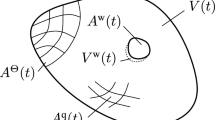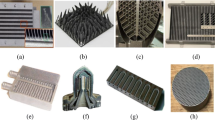Abstract
To improve the production efficiency of the hot-stamping process from the perspective of the die materials, a numerical model of a B-pillar component was established to investigate the effects of the thermal conductivity of the die material on the cooling behavior, microstructure, and mechanical evolution of the formed component, as well as the temperature distribution of the die during the hot-stamping process. The results showed that the thermal conductivity of the die material has a more significant influence on the quenching stage than the forming stage. Under the specified simulation and boundary conditions, when the thermal conductivity of the die material improves by 76.23% at 25–300 °C, the maximum cooling rate of the component increases by 48.49% and consequently improves the quenching efficiency of the hot-stamping process by 31.82%. As the thermal conductivity of the die steel increases, the maximum temperature of the die decreases and its temperature uniformity improves. Moreover, to improve the efficiency of the hot-stamping process, steels that possess high thermal conductivity at low temperature ranges are favorable.

























Similar content being viewed by others
References
H. Karbasian and A.E. Tekkaya, A Review on Hot Stamping, J. Mater. Process. Tech., 2010, 210, p 2103–2118
R. Neugebauer, F. Schieck, S. Polster, A. Mosel, A. Rautenstrauch, J. Schönherr et al., Press Hardening—An Innovative and Challenging Technology, Arch. Civ. Mech. Eng., 2012, 12, p 113–118
M. Merklein and J. Lechler, Investigation of the Thermo-Mechanical Properties of Hot Stamping Steels, J. Mater. Process. Tech., 2006, 177, p 452–455
K. Ji, O.E. Fakir, H. Gao, and L. Wang, Determination of Heat Transfer Coefficient for Hot Stamping Process, Mater. Today. Proceedings., 2015, 2, p 434–439
C. Lei, J. Cui, Z. Xing, H. Fu, and H. Zhao, Investigation of Cooling Effect of Hot-stamping Dies by Numerical Simulation, Phys. Procedia., 2012, 25, p 118–124
H. Hoffmann, H. So, and H. Steinbeiss, Design of Hot Stamping Tools with Cooling System, Cirp. Ann-Manuf. Techn., 2007, 56, p 269–272
E.J.F.R. Caron, K.J. Daun, and M.A. Wells, Experimental Heat Transfer Coefficient Measurements During Hot Forming Die Quenching of Boron Steel at High Temperatures, Int. J. Heat Mass Transf., 2014, 71, p 396–404
W.S. Lim, H.S. Choi, S.Y. Ahn, and B.M. Kim, Cooling Channel Design of Hot Stamping Tools for Uniform High-Strength Components in Hot Stamping Process, Int. J. Adv. Manuf. Technol., 2014, 70, p 1189–1203
H. Steinbeiss, H. So, T. Michelitsch, and H. Hoffmann, Method for Optimizing the Cooling Design of Hot Stamping Tools, Prod. Eng. Res. Devel., 2007, 1, p 149–155
Y. Xu and Z.D. Shan, Design Parameter Investigation of Cooling Systems for UHSS Hot Stamping Dies, Int. J. Adv. Manuf. Technol., 2014, 70, p 257–262
B. Casas, D. Latre, N. Rodriguez, I. Valls, Tailor Made Tool Materials for the Present and Upcoming Tooling Solutions in Hot Sheet Metal Forming, Luleå, Eds, Sweden, 2008, pp 22–24.
Y. Chang, X. Tang, K. Zhao, P. Hu, and Y. Wu, Investigation of the Factors Influencing the Interfacial Heat Transfer Coefficient in Hot Stamping, J. Mater. Process. Tech., 2016, 228, p 25–33
E. Kaschnitz, P. Hofer, and W. Funk, Thermophysical Properties of a Hot-Work Tool-Steel with High Thermal Conductivity, Int. J. Thermophys., 2013, 34, p 843–850
S. Li, X.C. Wu, S.H. Chen, and J.W. Li, Wear Resistance of H13 and a New Hot-Work Die Steel at High temperature, J. Mater. Eng. Perform., 2016, 25, p 2993–3006
S. Zhu, C. Li, C.H. Su, B. Lin, H. Ban, and R.N. Scripa, Thermal Diffusivity, Thermal Conductivity, and Specific Heat Capacity Measurements of Molten Tellurium, J. Cryst. Growth, 2003, 250, p 269–273
M.J. Peet, H.S. Hasan, and H.K.D.H. Bhadeshia, Prediction of Thermal Conductivity of Steel, Int. J. Heat Mass Transf., 2011, 54, p 2602–2608
Y. Terada, K. Ohkubo, T. Mohri, and T. Suzuki, Effects of Alloying Additions on Thermal Conductivity of Ferritic Iron, ISIJ Int., 2002, 42, p 322–324
M.C. Rukadikar and G. Reddy, Influence of Chemical Composition and Microstructure on Thermal Conductivity of Alloyed Pearlitic Flake Graphite Cast Irons, J. Mater. Sci., 1986, 21, p 4403–4410
W.A. Johnson and R.F. Mehl, Reaction Kinetics in Processes of Nucleation and Growth, Trans. Aime., 1939, 135, p 396–415
M. Avrami, Kinetics of Phase Change. I, General Theory, J. Chem. Phys., 1939, 7, p 1103–1112
L.F. He, G.Q. Zhao, and H.P. Li, Measurement and Analysis of Time-Temperature-Transformation Curves of Boron Steel 22MnB5, Appl. Mech. Mater., 2010, 29–32, p 484–489
H. Li, G. Zhao, and L. He, Finite Element Method Based Simulation Of Stress–Strain Field in the Quenching Process, Mater. Sci. Eng., A, 2008, 478, p 276–290
P. Hu, D. Shi, L. Ying, G. Shen, and W. Liu, The Finite Element Analysis of Ductile Damage During Hot Stamping of 22MnB5 Steel, Mater. Des., 2015, 69, p 141–152
P. Maynier, J. Dollet, and P. Bastien, Prediction of Microstructure Via Empirical Formulas Based on CCT Diagrams, Metallurgical Society AIME., 1978, 2, p 163–178
J. Cui, C. Lei, Z. Xing, C. Li, and S. Ma, Predictions of the Mechanical Properties And Microstructure Evolution of High Strength Steel in Hot Stamping, J. Mater. Eng. Perform., 2012, 21, p 2244–2254
M. Merklein and J. Lechler, Determination of Material and Process Characteristics for Hot Stamping Processes Of Quenchenable Ultra High Strength Steels with Respect to a FE-Based Process Design, SAE. Int. J. Mater. Manuf., 2008, 1, p 411–426
C. Wang, H. Zhou, P.Y. Lin, N. Sun, Q. Guo, and P. Zhang, The Thermal Fatigue Resistance of Vermicular Cast Iron Coupling with H13 Steel Units by Cast-in Process, Mater. Des., 2010, 31, p 3442–3448
D. Klobčar, J. Tušek, and B. Taljat, Thermal Fatigue of Materials for Die-Casting Tooling, Mater. Sci. Eng., A, 2008, 472, p 198–207
A. Srivastava, V. Joshi, and R. Shivpuri, Computer Modeling and Prediction of Thermal Fatigue Cracking in Die-Casting Tooling, Wear, 2004, 256, p 38–43
E. Paffumi, K.F. Nilsson, and Z. Szaraz, Experimental and Numerical Assessment of Thermal Fatigue in 316 Austenitic Steel Pipes, Eng. Fail. Anal., 2015, 47, p 312–327
J. Sjöström and J. Bergström, Thermal Fatigue Testing of Chromium Martensitic Hot-Work Tool Steel After Different Austenitizing Treatments, J. Mater. Process. Tech., 2004, 153–154, p 1089–1096
Acknowledgments
This work is supported by National Natural Science Foundation of China (Grant Nos. 51401117 and 51171104) and Innovation Foundation of Shanghai University.
Author information
Authors and Affiliations
Corresponding author
Rights and permissions
About this article
Cite this article
Li, S., Zhou, L., Wu, X. et al. The Influence of Thermal Conductivity of Die Material on the Efficiency of Hot-Stamping Process. J. of Materi Eng and Perform 25, 4848–4867 (2016). https://doi.org/10.1007/s11665-016-2332-9
Received:
Revised:
Published:
Issue Date:
DOI: https://doi.org/10.1007/s11665-016-2332-9




